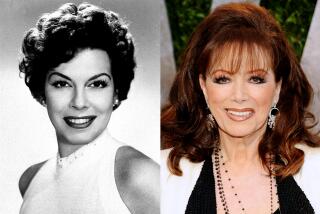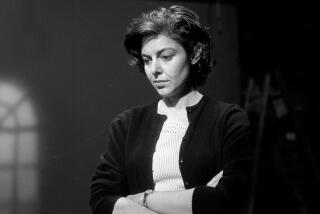BOOK REVIEW : The Best and Worst of Marital Relationships
- Share via
THE CLONING OF JOANNA MAY by Fay Weldon ; Viking $18.95, 265 pages
Finding the current varieties of relationships between men and women unsatisfactory, Fay Weldon tinkers with new ones. Her books are inventors’ workshops; future models stand in various stages of planning and construction.
They are odd, they are interesting, and some are quite brilliant. They have the energy of prototypes, and that superior vantage point from where That Which Might Be is able to dive-bomb That Which Is.
They have the abstract character of prototypes as well, energy rather than warmth. They are not user-friendly because they are not there for use but for stimulation. Some, in fact, are quite absurd. Even absurdity has its usefulness when you are trying to reinvent such a powerful machine as love.
Take the ideal couple in Weldon’s faintly loony, more than faintly disquieting, and exceedingly talky satire “The Cloning of Joanna May.” Man and woman, each does without the traditional romantic attributes of the two sexes. Angela, a history professor, is warty and given to instant and powerful judgments. Gerald is flabby and mild, a faceless bureaucrat in a British nuclear regulatory agency.
Yet: “Angela had gray skin, a double chin, short gray greasy hair, and wore belted navy blue around a waist larger than her hips, and her husband was never rude to her or tried to make her unhappy.”
It is a Weldon model of a decent marriage. Angela and Gerald are infinitely available to each other. When Angela has something to say, she drives into London and pulls Gerald out of a crucial meeting. (Chernobyl has spewed, and nuclear regulation is a moment-by-moment national crisis.) Not only does he come right out, but instead of returning to the meeting, he joins her in one of their favorite afternoon occupations: eating large quantities of stodgy food in the office cafeteria.
They are a small and furry couple out of some 21st-Century Beatrix Potter; they also rout the forces of evil; they also stand for prowess without traditional male heroics or female allure.
The forces of evil, which Gerald finally foils in a quiet bureaucratic fashion, are represented by half of another of Weldon’s odd pairs. He is Carl May, brought up in a slum and chained for much of his childhood to a doghouse. From there he could hear “I Dreamt I Dwelt in Marble Halls,” played on a neighbor’s gramophone. “He made the dream come true,” Weldon writes, “as few, just a few children can.”
He became a monster, a real estate tycoon, and owner of four antiquated nuclear power stations. His plants have no problem with leakage since they have no instrumentation to measure it.
May employs five killers who go around in the guise of a rock group. He is ruthless with his wife, Joanna. He denies her a baby; instead, he gets a scientist to remove one of her eggs, implant portions of it, parthenogenetically fertilized, in four women, and produce four clones. They reason is never quite clear; it seems to be a form of primitive capitalist accumulation, a kind of stockpiling of additional Joannas.
As for Joanna herself, Carl loves her in his reptilian fashion, even though he divorces her for infidelity and has her two lovers killed. What can you expect of a man raised in a dog kennel? Weldon manages a kind of universal chilly forgiveness by the end of the book, although for Carl, forgiveness does not preclude a grisly punishment.
The center of the book is, of course, Joanna. She is one vast female latency. Married or divorced, she is a creature of Carl’s, a captive goddess. Then one day, when she turns 60, a fearful windstorm comes--Weldon has no compunctions about unleashing her Furies from wherever is handiest--and knocks over her three largest trees. Something releases her.
“I found myself weeping,” Joanna tells us, “and that was very strange and wonderful.” The windstorm also brings varying degrees of damage and liberation to Jane, Julie, Gina and Alice, the four clones, now 30 years old and living their own lives. They and Joanna had known nothing of each other; now they begin to come together.
The book charts their gradual reassembling. It is like inserting rods in a reactor; a great force is created. “Wife I might be,” Joanna reflects, “but only part of me, for all of a sudden there was more of me left. The bugles had sounded, reinforcements came racing over the hill; Joanna May was now Alice, Julie, Gina, Jane as well. Absurd but wonderful!”
The five, assembled, go critical; the energy released rearranges everything. The women form a hive of purposeful, world-building activity. Their various attached males--Carl excepted--hang on in amiably peripheral capacity.
Weldon’s parable is funny, brainy and fierce. For long stretches, though, it drowns in talk. Most of it is done by Joanna as she grows into her goddess-hood. She is sonorous, elliptical, shrewd and funny, by turns. She is to be the future Mother of Us All, but how she does go on.
Next: Elaine Kendall reviews “Death of a Hollow Man” by Caroline Graham (William Morrow).


